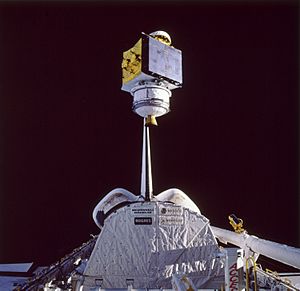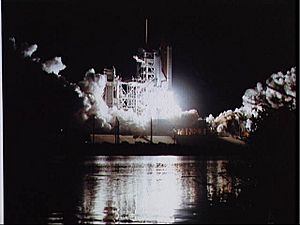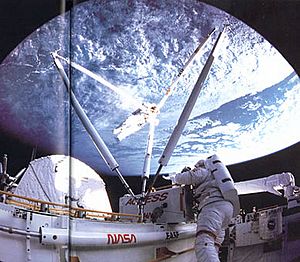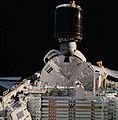STS-61-B facts for kids

Construction of the ACCESS structure.
|
|
| Names | Space Transportation System-23 |
|---|---|
| Mission type | Satellites deployment Technology |
| Operator | NASA |
| Mission duration | 6 days, 21 hours, 4 minutes, 49 seconds (achieved) |
| Distance travelled | 3,970,181 km (2,466,956 mi) |
| Orbits completed | 109 |
| Spacecraft properties | |
| Spacecraft | Space Shuttle Atlantis |
| Launch mass | 118,664 kg (261,609 lb) |
| Landing mass | 93,316 kg (205,727 lb) |
| Payload mass | 21,791 kg (48,041 lb) |
| Crew | |
| Crew size | 7 |
| Members |
|
| Start of mission | |
| Launch date | 27 November 1985, 00:29:00 UTC |
| Rocket | Space Shuttle Atlantis |
| Launch site | Kennedy Space Center, LC-39A |
| Contractor | Rockwell International |
| End of mission | |
| Landing date | 3 December 1985, 21:33:49 UTC |
| Landing site | Edwards Air Force Base, Runway 22 |
| Orbital parameters | |
| Reference system | Geocentric orbit |
| Regime | Low Earth orbit |
| Perigee | 361 km (224 mi) |
| Apogee | 370 km (230 mi) |
| Inclination | 28.45° |
| Period | 91.90 minutes |
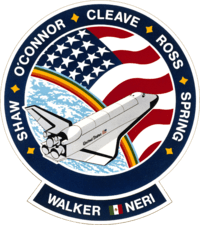 STS-61-B mission patch 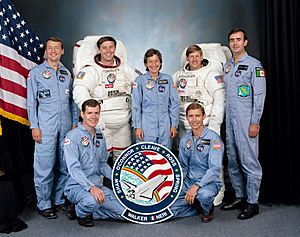 Back row: Charles D. Walker, Jerry L. Ross, Mary L. Cleave, Sherwood C. Spring, Rodolfo Neri Vela Front row: Bryan D. O'Connor, Brewster H. Shaw Jr. |
|
STS-61-B was the 23rd Space Shuttle mission by NASA. It was the second flight for the Space Shuttle Atlantis. The shuttle launched from Kennedy Space Center, Florida, on November 26, 1985.
During this mission, the crew launched three communications satellites. They also tested new ways to build large structures in space. Atlantis landed at Edwards Air Force Base, California, on December 3, 1985. The mission lasted almost 7 days.
STS-61-B set a record for the fastest turnaround time for a Space Shuttle. Only 54 days passed between Atlantiss previous flight and this one. This record still stands today. The mission was also special because it carried the first Mexican astronaut, Rodolfo Neri Vela. This was Atlantiss last flight before the Space Shuttle Challenger disaster in 1986.
Contents
Meet the Crew
Seven astronauts flew on the STS-61-B mission. They worked together to complete all the mission's goals.
| Position | Astronaut | |
|---|---|---|
| Commander | Second spaceflight |
|
| Pilot | First spaceflight |
|
| Mission Specialist 1 | First spaceflight |
|
| Mission Specialist 2 | First spaceflight |
|
| Mission Specialist 3 | Only spaceflight |
|
| Payload Specialist 1 | Third and last spaceflight |
|
| Payload Specialist 2 | Only spaceflight |
|
What the Shuttle Carried
The Space Shuttle Atlantis carried several important items into space. Its main job was to deploy three communication satellites. These satellites help with TV, radio, and phone calls around the world.
- Aussat-2: This satellite was for Australia.
- Morelos-2: This satellite was for Mexico.
- Satcom-K2: This satellite was for the United States.
Each satellite had a special booster rocket attached. This booster helped them reach their correct high orbit around Earth. All three satellites were successfully launched and moved into their proper positions.
Experiments on Board
The mission also carried several experiments. These were done in a special area of the shuttle called the Middeck.
- Continuous Flow Electrophoresis System (CFES): This experiment worked on making very pure medical products in space.
- Diffusive Mixing of Organic Solutions (DMOS): This experiment tried to grow larger and purer crystals than possible on Earth.
- Morelos Payload Specialist Experiments (MPSE): These were experiments related to the Mexican astronaut's research.
- Orbiter Experiments (OEX): These experiments tested how the shuttle flew.
Other Interesting Items
A checkered racing flag was flown on Atlantis. This flag is now on display at the Indianapolis Motor Speedway Museum. The mission also tested an advanced autopilot system for the shuttle. This system helped the shuttle fly more efficiently and save fuel.
Mission Highlights
Space Shuttle Atlantis launched at night on November 26, 1985. This was the second night launch for the Space Shuttle program. It was also the ninth and final shuttle flight of 1985.
A big part of the mission was the EASE/ACCESS experiment. This experiment helped scientists learn how to build large structures in space. It was a joint project between two NASA centers.
ACCESS was a tall tower made of many small parts. EASE was a pyramid-shaped structure made of a few large beams. These experiments showed that it is possible to build big things in space. Astronauts Ross and Spring did two spacewalks to work on these structures. An IMAX camera filmed their activities.
The astronauts found that ACCESS was easier to build. EASE required more effort because they had to move their own bodies while holding the large beams. They learned that astronauts could do long spacewalks every other day. They also suggested changing gloves to prevent hand fatigue.
During the mission, astronaut Rodolfo Neri Vela performed several experiments. These focused on how the human body reacts to space. He also took many photos of Mexico and Mexico City from space. Astronaut Charles Walker continued his work with the CFES experiment. This helped produce important medical products. The DMOS experiment for 3M was also successful. It aimed to grow perfect crystals in microgravity. A Canadian student experiment also flew. It tested making mirrors in space.
All experiments on STS-61-B were successful. Atlantis landed safely at Edwards Air Force Base on December 3, 1985. The mission lasted nearly seven days.
Spacewalks
Astronauts Jerry L. Ross and Sherwood C. Spring performed two spacewalks. These spacewalks were important for practicing how to build a space station.
| EVA | Spacewalkers | Start (UTC) | End | Duration |
|---|---|---|---|---|
| EVA 1 | Jerry L. Ross Sherwood C. Spring |
29 November 1985 | 29 November 1985 | 5 hours 32 minutes |
| During their first spacewalk, Ross and Spring practiced building a tower called ACCESS. They put together the 3.4-meter (11-foot) tower very quickly. They even built it twice! They also worked on EASE, a 3.6-meter (12-foot) pyramid. They built this structure eight times. This helped them understand how easy or hard it was to build things while floating in space. | ||||
| EVA 2 | Jerry L. Ross Sherwood C. Spring |
1 December 1985 | 1 December 1985 | 6 hours 41 minutes |
| The second spacewalk focused on how astronauts could handle large parts for a space station. They also tested how the shuttle's robotic arm (Canadarm) could help. Ross and Spring built more of the ACCESS tower. They practiced moving parts with the robotic arm. They also simulated repairing the tower. These spacewalks showed that astronauts could build and repair structures in space. | ||||
Wake-up Calls
NASA has a fun tradition of playing music to wake up astronauts. The songs are often chosen by the astronauts' families. They usually have a special meaning to a crew member or relate to their daily tasks.
| Flight Day | Song | Artist/Composer | Played for |
|---|---|---|---|
| Day 2 | "Air Force Hymn" | Brewster H. Shaw Jr. | |
| Day 3 | "America the Beautiful" | ||
| Day 4 | "Marine Corps Hymn" | Bryan O'Connor | |
| Day 5 | "Notre Dame Victory March" | Jerry L. Ross | |
| Day 6 | "Born in the U.S.A." | Bruce Springsteen |
Images for kids
See also
 In Spanish: STS-61-B para niños
In Spanish: STS-61-B para niños


